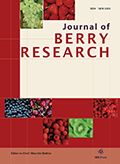Authors: Gustafson, Sally J. | Yousef, Gad G. | Grusak, Michael A. | Lila, Mary Ann
Article Type:
Research Article
Abstract:
In this study, we quantified anthocyanin (ANC), proanthocyanidin (PAC), and chlorogenic acid (CA) concentrations in wild blueberry fruit (WBB) exposed to a variety of postharvest handling practices relevant to consumers and to industry. Additionally, we analyzed the bioactive potential of WBB subjected to common culinary preparations such as baking, boiling, and microwaving. Levels of ANC, PAC, and CA in individually quick frozen (IQF) WBB that had been subjected to temperature fluctuations, which are often encountered during distribution and handling for retail sales, dropped by approximately 8, 43, and 60%, respectively, compared to an IQF WBB composite that was stored continuously
…from harvest at −80°C. Baking IQF WBB reduced ANC, PAC, and CA concentrations by 11.2, 14.6, and 10.6%, respectively, and boiling decreased ANC, PAC, and CA concentrations by a minimum of 7.4, 14.4, and 36.8%, respectively. Microwaving IQF WBB for 1 minute increased ANC concentrations by 12.9% but exposure to 3 and 5 minutes resulted in significant decreases (29.8 and 81.6%, respectively). PAC concentrations in IQF WBB exposed to microwaves for 1, 3, and 5 minutes decreased by 14.3, 5.4, and 87.1%, respectively, whereas CA concentrations were not significantly impacted. At a concentration of 25 μg/ml, baked and boiled IQF WBB extracts maintained the ability to inhibit lipopolysaccharide (LPS)-induced reactive oxygen species (ROS) in SH-SY5Y cells. Extracts of WBB that were microwaved for 1 or 3 minutes retained bioactivity in our model for inflammation, while those microwaved for 5 minutes were unable to inhibit LPS-induced ROS.
Show more
Keywords: Blueberry, polyphenols, reactive oxygen species, HPLC, anthocyanins, polyphenol oxidase
DOI: 10.3233/JBR-2012-041
Citation: Journal of Berry Research,
vol. 2, no. 4, pp. 215-227, 2012





